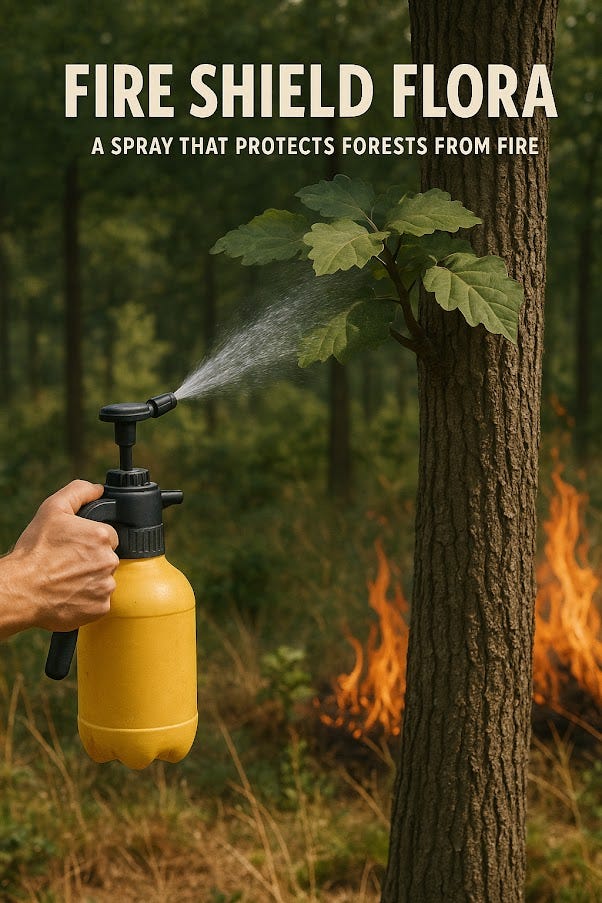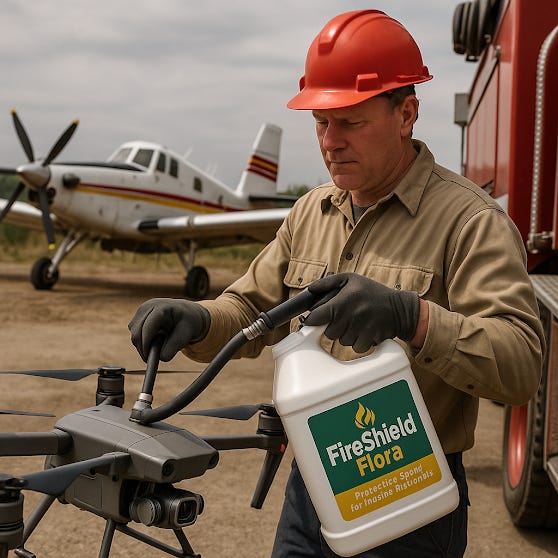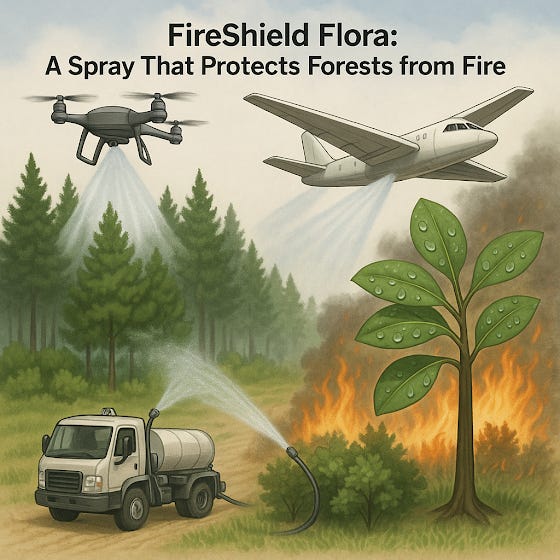FireShield Flora: Protective Spray for Wildfire Prevention in Forest Ecosystems
FireShield Flora: Protective Spray for Wildfire Prevention in Forest Ecosystems
By Ronen Kolton Yehuda (Messiah King RKY)
Abstract
Wildfires are escalating in frequency and intensity due to climate change, poor land management, and extreme drought. Forests, once resilient ecosystems, are increasingly vulnerable. FireShield Flora is a proposed protective spray applied to trees, shrubs, and ground vegetation to reduce flammability, slow fire spread, and protect ecological zones during peak fire seasons.
1. Problem Overview
Modern wildfires destroy millions of hectares annually. Even fire-resistant species can be overwhelmed when:
Leaf moisture content drops below 30%
Resin or oil levels increase in dry seasons
Wind and topography accelerate flame spread
Current firebreak strategies (like cutting vegetation) are often reactive and labor-intensive. A proactive biological spray solution could greatly reduce risk.
2. FireShield Flora – Concept Summary
FireShield Flora is a non-toxic, biodegradable spray that coats plant surfaces with a thin, protective layer that:
Increases ignition temperature
Reduces oxygen access to surface particles
Delays combustion time
Retains moisture
Minimizes ember ignition
3. Proposed Formula (Example)
Ingredient Function
Colloidal silica gel Forms a heat-resistant, fire-suppressing barrier
Hydrogel-based moisture binder Holds water near plant tissue during dry periods
Non-toxic fire retardant salts (e.g., ammonium polyphosphate) Inhibits combustion reactions
Biodegradable polymer binder Adheres spray to leaves and bark for 2–4 weeks
UV-blocker additives Prevent sunlight degradation of spray filmOptional: Natural oils with anti-fungal or insect-repelling properties
4. Application Methods
Aerial spraying via drones or aircraft for large forest areas
Ground spraying for protected zones, urban forests, or buffer zones
Pre-seasonal treatment or emergency zone response before extreme heatwaves
5. Safety and Environmental Considerations
Biodegradable within 4–6 weeks
Safe for animals, pollinators, and water systems
Leaves no toxic residues in soil or foliage
Can be adapted for edible plants and orchards with food-grade variants
6. Strategic Use Cases
Urban-forest interface zones (WUI regions)
National park fire buffers
Highway or utility corridor fire protection
Preservation of old-growth or heritage trees
7. Integration with AI & Monitoring
The spray can be used in tandem with AI-based fire risk maps, using weather, vegetation dryness, and terrain to guide targeted deployment. Integration with satellite or drone systems allows early re-spray warnings based on real-time heat, wind, or plant health data.
Conclusion
FireShield Flora offers a scalable, affordable, and sustainable approach to wildfire prevention. By reinforcing nature’s barriers without harming the ecosystem, we can protect both plant life and human communities.
FireShield Flora: Technical Solution for Wildfire Prevention via Aerial and Ground Spraying
By Ronen Kolton Yehuda (Messiah King RKY)
Forests may burn, but solutions must rise with the smoke.
1. Introduction
Climate-induced wildfire events are devastating natural ecosystems, displacing wildlife, endangering human lives, and accelerating carbon emissions. Traditional methods—firebreaks, tree thinning, controlled burns—are insufficient in isolation. There is a growing need for proactive, large-scale, and safe preventive measures.
FireShield Flora is a biodegradable plant-coating spray designed to resist ignition, retain moisture, and slow fire propagation, enabling precious time for containment and evacuation. It is engineered for mass deployment using drones, airplanes, helicopters, or mobile spraying vehicles.
2. FireShield Flora – Core Technology
2.1 Composition (Formulation)
ComponentPurposeColloidal silica & bentonite gelHeat-resistant surface coating to reduce ignition riskHydro-retaining polymersBind and hold moisture within plant surfacesAmmonium polyphosphate (APP)Fire retardant salt that slows combustion reactionBiodegradable adhesion polymerEnsures spray adheres for 2–4 weeksUV-stabilizersPrevent degradation from sunlight
Each component is non-toxic, biodegradable, and optimized for leaf and bark application.
2.2 Protective Mechanism
Surface Insulation: Forms a thin transparent shield that resists heat transmission to plant tissue.
Moisture Retention: Retains water, increasing internal leaf moisture threshold and delaying flashpoint.
Combustion Inhibition: Fire retardants chemically interfere with oxidation and flame propagation.
3. Deployment Systems
3.1 Aerial Spraying
Fixed-Wing Aircraft: Effective for covering hundreds of hectares during fire seasons or in vulnerable zones. Can be coordinated with satellite AI fire-risk maps.
Rotary-Wing Helicopters: Ideal for targeted missions over specific forests or tree belts near urban areas.
Drones (UAVs): Low-altitude precision spraying. Especially effective for:
Forest edge zones (urban interfaces)
Tree tops and hard-to-reach canopies
Emergency application during fire alerts
3.2 Ground-Based Systems
Tractor-mounted boom sprayers for rural or managed forests
Backpack sprayers for sensitive ecological or manual preservation zones
Smart-vehicle mounted systems for roadsides, parks, and orchards
4. Use Protocols and Cycles
Condition Recommended Frequency
Pre-fire season (dry summer prep) Every 2–4 weeks
During heatwave/fire watch alerts 1 week prior or immediately upon alert
High-risk zones (e.g. eucalyptus groves) Weekly or AI-monitored reapplication
Post-fireline reinforcement 1–2 days after area is contained
5. Environmental Safety
Water-safe: Will not contaminate streams or groundwater
Pollinator-safe: Non-harmful to bees, butterflies, and beneficial insects
No soil residue: Breaks down in sunlight and microbial activity after 4–6 weeks
Edible variant: Available for orchards and farms using food-safe compounds
6. Integration with AI and Sensor Networks
FireShield Flora can be deployed based on real-time fire-risk algorithms, using:
Thermal imaging and dryness indices
Weather forecasts and wind speed alerts
Vegetation-type databases
Drone-based LiDAR scanning of biomass
Spraying schedules and coverage patterns are optimized with autonomous AI ground control systems.
7. Benefits at Scale
Reduces fire ignition in treated vegetation by up to 70–90%
Gains critical minutes to hours in containment efforts
Enhances firefighter safety by reducing flame intensity in treated zones
Scalable to national forest programs or municipal fire zones
Supports insurance-backed protection models for protected lands
Conclusion
FireShield Flora is not merely a product—it's a preventive layer of resilience for Earth's lungs. With aerial and automated deployment capacity, it transforms wildfire management from reactive to proactive. When layered with AI intelligence and sustainable materials, it represents a new standard in ecological protection technology.
🔬 Formula Version A – Forest Fire Prevention (General Forest Zones)
Use case: Forests, parks, and wildland–urban interfaces.
Ingredient Function
Colloidal silica (5%) Forms a heat-resistant protective shell on leaves and bark
Hydrogel polymer (3%) Absorbs and retains water to prevent dehydration
Ammonium polyphosphate (APP, 8%) Fire retardant salt that delays ignition
Biodegradable latex binder (4%) Adheres solution to plant surfaces for weeks
UV stabilizers (0.5%) Protect spray film from sun degradation
pH-neutral carrier water (79.5%) Dilution medium for safe spray delivery
✅ Withstands rain up to 20 mm
🕒 Effective for 2–3 weeks
🌲 Best for pine, oak, eucalyptus, and mixed forests
🌿 Formula Version B – Eco Sensitive Zones / Wildlife Protection Areas
Use case: Protected forests, national parks, nature reserves.
Ingredient Function
Bentonite clay (4%) Natural fire-suppressant and moisture insulator
Glycerol (2%) Plant-safe humectant for moisture retention
Bio-sugar polymers (e.g., pullulan) (3%) Film-forming edible polymer
Potassium bicarbonate (4%) Mild, eco-friendly fire retardant
Essential oil blend (0.5%) Optional: lavender/eucalyptus for mild insect repellence
Natural water base (86.5%) No chemical stabilizers
✅ Safe for pollinators and amphibians
🐝 Fully bee- and butterfly-safe
🕒 Effective for 1–2 weeks
🍎 Formula Version C – Orchards and Edible Crops (Food-Safe)
Use case: Fruit trees, vineyards, agricultural buffers.
Ingredient Function
Food-grade xanthan gum (1.5%) Natural film-forming agent
Calcium lactate (2%) Mild retardant and plant-strengthening mineral
Potassium bicarbonate (3%) Edible fire retardant and fungal suppressant
Edible-grade hydrogel (2%) Moisture retention without toxicity
Citrus peel extract (0.5%) Natural antioxidant and UV protection
Purified water (91%) Food-safe spray medium
✅ Conforms to food safety standards
🍋 Edible up to 48 hours after spray
🚜 Ideal for apple, citrus, olive, and grape trees
🛡️ Formula Version D – Emergency Barrier Spray (High-Risk Zones)
Use case: Fire approaching towns, highways, or structures.
Ingredient Function
Ammonium phosphate + APP (10%) Strong fire retardant salt combination
Silicone-based heat shield polymer (5%) Builds a flexible thermal barrier
Hydrogel composite (3%) Water retention and adhesion under heat
Biodegradable surfactant (1%) Helps coating spread evenly on foliage
Stabilized water base (81%) Pressurized or drone-spray ready
🔥 Used in red-flag fire weather
⛑️ Applied around structures, roadsides, or fire perimeters
🚁 Compatible with drone, truck, or helicopter deployment
FireShield Flora: A Spray That Protects Forests from Fire
As wildfires grow stronger and more destructive each year, the need to protect our forests, parks, and green areas becomes more urgent. One of the newest solutions being developed is FireShield Flora—a special spray that helps prevent trees and plants from catching fire.
This spray creates an invisible shield on leaves, bark, and grasses. It keeps moisture inside the plant, makes the surface harder to ignite, and slows down the spread of fire. It’s like giving the forest its own layer of armor.
How It Works
FireShield Flora is made from safe, natural ingredients. These include minerals that resist heat, water-holding gels, and plant-safe coatings that stick to trees and stay there even in dry weather. The spray doesn’t harm animals, insects, or water sources. It disappears naturally after a few weeks.
Some versions are even safe to use on fruit trees and farms, so the spray can help protect valuable crops during extreme heat or fire warnings.
How It’s Used
FireShield Flora can be sprayed in many ways:
From the air using airplanes, helicopters, or firefighting drones
By land using tractors, mobile sprayers, or even backpacks
Around towns and roads to create safe buffer zones between people and wildlands
It can be used before fire season as a safety layer, or during fire emergencies to slow the flames and buy time for firefighters.
Why It Matters
This spray isn’t just about stopping fire. It’s about saving forests, homes, animals, and even lives. By preventing the first spark or slowing a fire’s growth, we give nature and people a better chance to respond and recover.
As part of a larger fire prevention strategy—alongside tree care, AI monitoring, and smart firefighting—FireShield Flora offers a new way to protect the world’s green lungs.
A Safer Future for Forests
With climate change making wildfires more common, every tool we can use matters. FireShield Flora is an idea rooted in science, made for nature, and designed to help forests stay forests—green, growing, and alive.


















